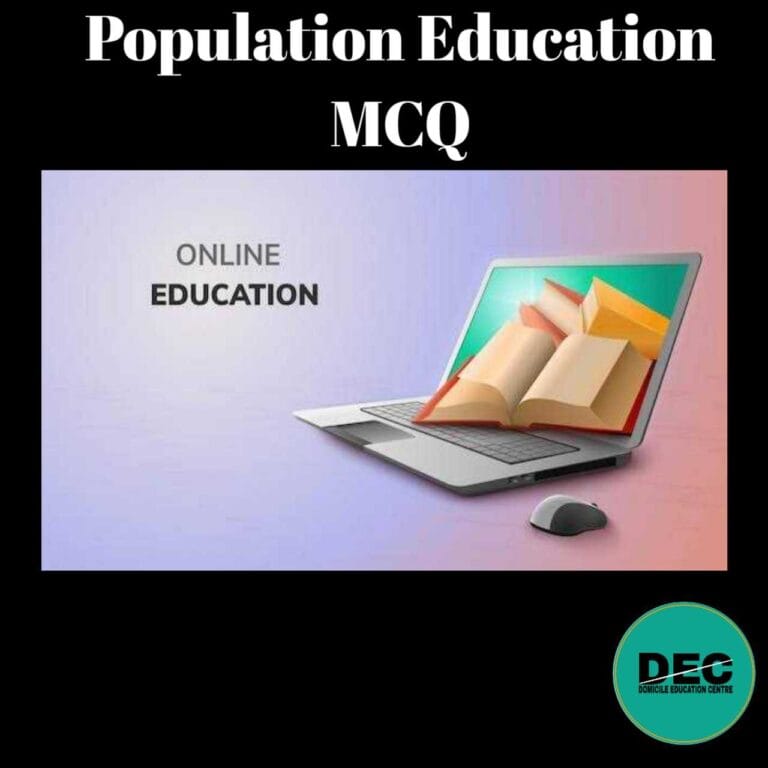Here You will get all MCQ questions answer based on Population Education for Class-12.
1. The term ‘demography’ refers to-
A. Study of population
B. Study of animals
C. Study of fossils
D. Study of environment
Ans: Option A. Study of population
2. Who introduced the concept of ‘Population Education’?
A. Ministry of Environment
B. NCERT
C. WHO
D. World Bank
Ans: Option B. NCERT
3. Population Education focusses on-
A. Historical events
B. Physical education
C. Environmental Conservation
D. Population dynamics and Family
Ans: Option D. Environmental dynamics and Family
4. The main objective of population education is to-
A. To reduce population migration
B. Increasing population growth
C. To control birth rate
D. To create awareness about population issues
Ans: Option D. To create awareness about population issues
5. Which one of the following is not a component of population education?
A. Astrology
B. Fertility
C. Morality
D. Migration
Ans: Option D. Migration
6. Population explosion refers to-
A. Rapid and excessive population growth
B. Migration of people
C. Balanced population growth
D. Decline in population
Ans: Option A. Rapid and excessive population growth
7. Family planning is one of the major tools to achieve-
A. Increase birth rate
B. Political stability
C. Economic crisis
D. Population control
Ans: Option D. Population control
8. Which of the following is a result of overpopulation?
A. Food surplus
B. High literacy rate
C. Population control
D. Unemployment
Ans: Option D. Unemployment
9. Population education mainly aim at-
A. Promoting migration
B. Improving agriculture practice
C. To promote political education
D. Creating awareness about population issues
Ans: Option D. Creating awareness about population issues.
10. Which of the following is a key objective of population education?
A. Promoting gender inequality
B. Understanding population dynamic
C. Discouraging education
D. Encouraging early marriages
Ans: Option B. Understanding population dynamic
11. Which organization has played a significant role in promoting population education in India?
A. FIFA
B. WTO
C. NCERT
D. WHO
Ans: Option C. NCERT
12. Population education is important because it helps individuals-
A. Build houses
B. Increase population
C. Plan for a small family
D. Learn a new language
Ans: Option C. Plan for a small family
13. Family planning is an important component of-
A. Political science
B. Environmental studies
C. Commerce
D. Population education
Ans: Option D. Population education
14. Which factor contributes most to rapid population growth in developing countries?
A. Urbanization
B. Low birth rate
C. High death rate
D. High birth rate
Ans: Option D. High birth rate
14. One of the strategies to control population growth is-
A. Encouraging child marriage
B. Reducing life expectancy
C. Promoting polygamy
D. Providing education and health services
Ans: Option D. Providing education and health services
16. Population education is a part of which broader subject?
A. Chemistry
B. Environmental education
C. Political science
D. Mathematics
Ans: Option B. Environmental education
17. Which of the following is not a component of population education?
A. Agriculture techniques
B. Family planning
C. Gender equality
D. Demography
Ans: Option A. Agriculture techniques
18. Which organization played a major role in the development of population education?
A. UNESCO
B. FAO
C. ILO
D. WHO
Ans: Option A. UNESCO
Archives
19. Population explosion played leads to-
A. Abundant natural resources
B. Low dependency ratio
C. Improved living standards
D. Increased unemployment
Ans: Option D. Increased unemployment
20. Which of the following is a reason for rapid population growth in developing countries?
A. High death rate
B. High literacy rate
C. Late marriages
D. Lack of awareness about family planning
Ans: Option D. Lack of awareness about family planning
21. Which method is commonly used in population control programs?
A. Migration
B. Immunization
C. Contraceptive use
D. Urbanization
Ans: Option C. Contraceptive use
22. The term ‘population density’ refers to-
A. Number of cities in a country
B. Number of populations living per square kilometre
C. Number of deaths per year
D. Number of children born per women
Ans: Option B. Number of populations living per square kilometre
23. Which of the following is a result of overpopulation?
A. Decrease in population
B. Increase in per capita income
C. Resource depletion
D. Better job opportunities
Ans: Option C. Resource depletion
24. Population education is included in the school curriculum to-
A. Teach economic polices
B. Educate about population related issues and solution
C. Encourage early marriage
D. Promote migration
Ans: Option B. Educate about population related issues and solution
25. Which of the following is an indicator of population growth?
A. Migration rate
B. Birth rate
C. Death rate
D. All of the above
Ans: Option D. All of the above
26. Which of these is not a method of contraception?
A. Condoms
B. Meditation
C. Copper-T
D. Oral pills
Ans: Option B. Meditation
27. The concept of ‘replacement level ferity’ means-
A. No children
B. Two children per couple
C. More than two children
D. One child per couple
Ans: Option B. Two children per couple
28. Family planning helps in-
A. Reducing morality rate
B. Increasing dependency ratio
C. Increasing fertility
D. Controlling population growth
Ans: Option D. Controlling population growth
Recent Posts
Calendar of Content List:
| M | T | W | T | F | S | S |
|---|---|---|---|---|---|---|
| 1 | 2 | 3 | 4 | 5 | 6 | 7 |
| 8 | 9 | 10 | 11 | 12 | 13 | 14 |
| 15 | 16 | 17 | 18 | 19 | 20 | 21 |
| 22 | 23 | 24 | 25 | 26 | 27 | 28 |
| 29 | 30 | 31 | ||||


Recent Comments